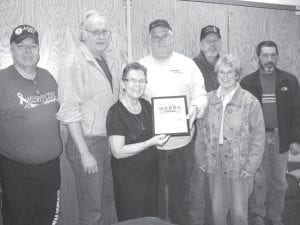Rosemary Lamson, the daughter of Dr. Wallace “Doc” Smith, receives her father’s amateur radio QSL Card at the Boundary Waters Amateur Radio Club (BWARC) April 2012 meeting. Doc Smith was responsible for much of the growth of amateur radio in Cook County. At the presentation were (L-R) Dan Riddle, Rick Johnson, Rosemary Lamson, Pat Scully, Jerry Sivets, Kay Sivets and Doug Turner.

Rick Johnson is a local amateur radio operator and an active member of the Boundary Waters Amateur Radio Club (BWARC). Earlier this spring he received an email from a friend telling him that an interesting old QSL Card was being auctioned on e-Bay. A Grand Marais resident, the late Dr. Wallace “Doc” Smith, had originated the card. Johnson quickly bid on the card and was able to win it for the BWARC archives.
In 1949, Doc Smith had sent the card to an amateur radio operator in Falls Church, Virginia and it somehow made its way to the on-line auction site. The club presented a framed copy of the card to Grand Marais resident Rosemary Lamson, daughter of Doc Smith, in honor of her father’s many contributions to amateur radio in Cook County.
Doc Smith was a Grand Marais doctor for many years and was responsible for much of the spread of amateur radio in Cook County. When he passed away, the Boundary Waters Amateur Radio Club (BWARC) adopted his call sign, W0BBN, as a lasting tribute to him.
Amateur radio operators use things called “Q codes” as shorthand for common sentences or questions. These codes date back to the time when much of amateur radio communication was sent as Morse Code. The “QSL” code can be a statement or a question depending on the context—“Did you get my message”? Or “Yes, I did.”
QSL Cards are used to confirm a twoway radio communication between amateur radio stations and they can also confirm the reception of a two-way radio communication by a third party listener. QSL Cards are typically the same size and made from the same material as a standard postcard and most are sent through the mail.


Loading Comments